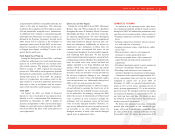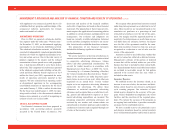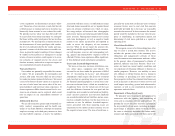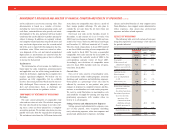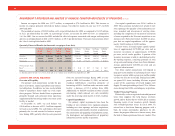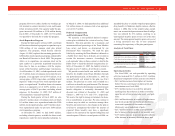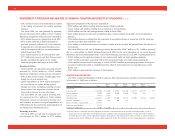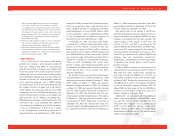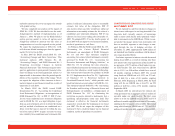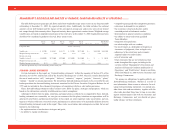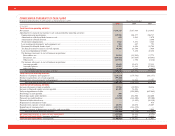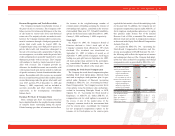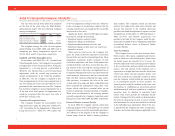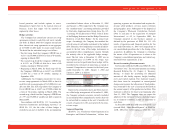Advance Auto Parts 2005 Annual Report Download - page 35
Download and view the complete annual report
Please find page 35 of the 2005 Advance Auto Parts annual report below. You can navigate through the pages in the report by either clicking on the pages listed below, or by using the keyword search tool below to find specific information within the annual report.
Advance Auto Parts
I
Annual Report 2005
I
33
method to amortize the cost as an expense for awards
with graded vesting.
We have completed our analysis of the impact of
SFAS No. 123R. We have decided to use the modi-
fied-prospective method of implementation as of
January 1, 2006. We plan to use the Black-Scholes
option pricing model to value all options and
straight-line method to amortize this fair value as
compensation cost over the required service period.
We expect the implementation of SFAS No. 123R
will decrease diluted earnings per share by approxi-
mately $0.12 for fiscal 2006.
In May 2005 the FASB issued SFAS No. 154,
“Accounting Changes and Error Corrections.” This
statement replaces APB Opinion No. 20,
“Accounting Changes,” and FASB Statement No. 3
“Reporting Accounting Changes in Interim
Financial Statements.” This Statement requires retro-
spective application to prior periods’ financial state-
ments of changes in accounting principle, unless it is
impracticable to determine either the period-specific
effects or the cumulative effect of the change. We do
not expect the adoption of this statement to have a
material impact on our financial condition, results of
operations or cash flows.
In March 2005 the FASB issued FASB
Interpretation No. 47, “Accounting for Conditional
Asset Retirement Obligations—an interpretation of
FASB Statement No. 143,” or FIN 47. FIN 47 clari-
fies the term conditional asset retirement obligation
used in FASB No. 143 as a legal obligation to per-
form an asset retirement activity in which the timing
and (or) method of settlement are conditional on a
future event that may or may not be within the con-
trol of the entity. FIN 47 requires an entity to recog-
nize a liability for a conditional asset retirement obli-
gation if sufficient information exists to reasonably
estimate fair value of the obligation. FIN 47
also clarifies when an entity would have sufficient
information to reasonably estimate the fair value of a
conditional asset retirement obligation. FIN 47 was
effective for fiscal years ending after December 15,
2005. We adopted FIN 47 in the fourth quarter of
fiscal 2005 with no impact to our financial condition,
results of operations or cash flows.
In February 2006 the FASB issued SFAS No. 155,
“Accounting for Certain Hybrid Financial
Instruments—an amendment of FASB Statements
No. 133 and 140.” This statement simplifies
accounting for certain hybrid instruments currently
governed by FASB No. 133, “Accounting for
Derivative Instruments and Hedging Activities,” or
SFAS No. 133, by allowing fair value remeasure-
ment of hybrid instruments that contain an embedded
derivative that otherwise would require bifurcation.
This statement also eliminates the guidance in FASB
No. 133 Implementation Issue No. D1, “Application
of Statement 133 to Beneficial Interests in
Securitized Financial Assets,” which provides such
beneficial interests are not subject to FASB No. 133.
This statement amends FASB No. 140, “Accounting
for Transfers and Servicing of Financial Assets and
Extinguishments of Liabilities—a Replacement of
FASB Statement No. 125,” by eliminating the
restriction on passive derivative instruments that a
qualifying special-purpose entity may hold. This
statement is effective for financial instruments
acquired or issued after the beginning of our fiscal
year 2007. We do not expect the adoption of this
statement to have a material impact on our financial
condition, results of operations or cash flows.
QUANTITATIVE AND QUALITATIVE DISCLOSURES
ABOUT MARKET RISKS
We are exposed to cash flow risk due to changes in
interest rates with respect to our long-term debt. Our
long-term debt currently consists of borrowings
under a senior credit facility and is primarily vulner-
able to movements in the LIBOR rate. While we can-
not predict the impact interest rate movements will
have on our debt, exposure to rate changes is man-
aged through the use of hedging activities. At
December 31, 2005, approximately $200 million of
our bank debt was fixed in accordance with the interest
rate swaps described below.
Our future exposure to interest rate risk decreased
during fiscal 2005 as a result of entering into three
new interest rate swap agreements in March 2005 on
an aggregate of $175 million of debt under our sen-
ior credit facility. The first swap fixed our LIBOR
rate at 4.153% on $50 million of debt for a term of
48 months, expiring in March 2009. The second
swap fixed our LIBOR rate at 4.255% on $75 mil-
lion of debt for a term of 60 months, expiring
February 2010. Beginning in March 2006, the third
swap will fix our LIBOR rate at 4.6125% on $50
million of debt for a term of 54 months, expiring
September 2010.
In March 2003 we entered into two interest rate
swap agreements on an aggregate of $125 million of
our debt under our credit facility. The first swap
allows us to fix our LIBOR rate at 2.269% on $75.0
million of variable rate debt for a term of 36 months,
expiring in the first quarter of fiscal 2006. The second
swap, which fixed our LIBOR rate at 1.79% on $50.0
million of variable rate debt, expired in March 2005.


